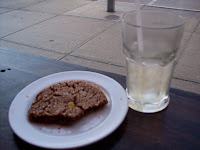meanderthals for literacy
Meanderthals are guided by desire lines.
Desire lines, as you may know, are defined by architects and urban planners as those trampled-down footpaths that deviate from official (i.e. pre-planned and paved) directional imperatives. These pathways of desire cut across university campuses, they carve up the urban grid, they exceed the boundaries of the sidewalk; in so doing desire paths express the excess that premeditated constructions cannot foresee or contain. Desire lines objectify the constraints of the concrete. In so doing, they reveal new potential trajectories, in turn opening the urban traveler to new experiences of space, place, and time: a getaway-from-the-everyday.
A desire path (or desire line) is a path developed by erosion caused by animal or human footfall. The path usually represents the shortest or most easily navigated route between an origin and destination. The width and amount of erosion of the line represents the amount of demand. The term was coined by Gaston Bachelard in his book The Poetics of Space. Desire paths can usually be found as shortcuts where constructed pathways take a circuitous route.
They are manifested on the surface of the earth in certain cases, e.g., as dirt pathways created by people walking through a field, when the original movement by individuals helps clear a path, thereby encouraging more travel. Explorers may tread a path through foliage or grass, leaving a trail "of least resistance" for followers.
The lines may be seen along an unpaved road shoulder or some other unpavednatural surface. The paths take on an organically grown appearance by being unbiased toward existing constructed routes. These are almost always the most direct and the shortest routes between two points, and may later be surfaced.
Whenever we talk about literacy and learning in the ways we experience it, we create desire lines. The depth of our groove is evidence of our joy and our passion. Our desire lines will encourage more travel in this direction.











No comments:
Post a Comment